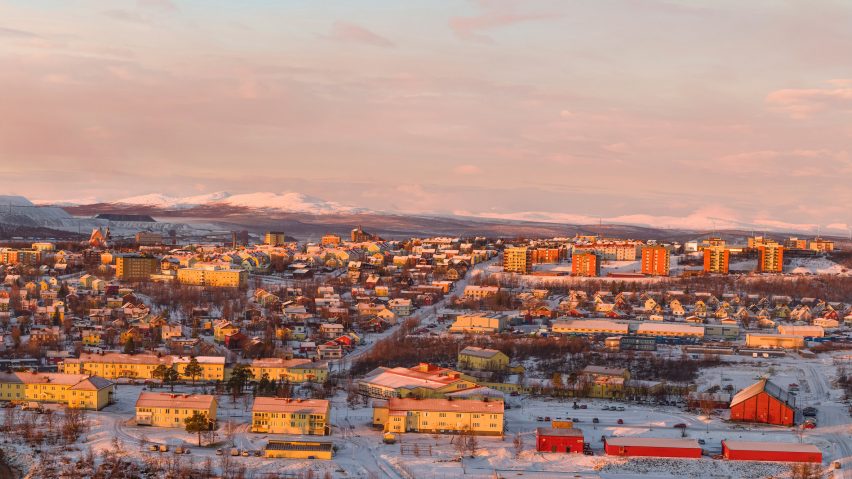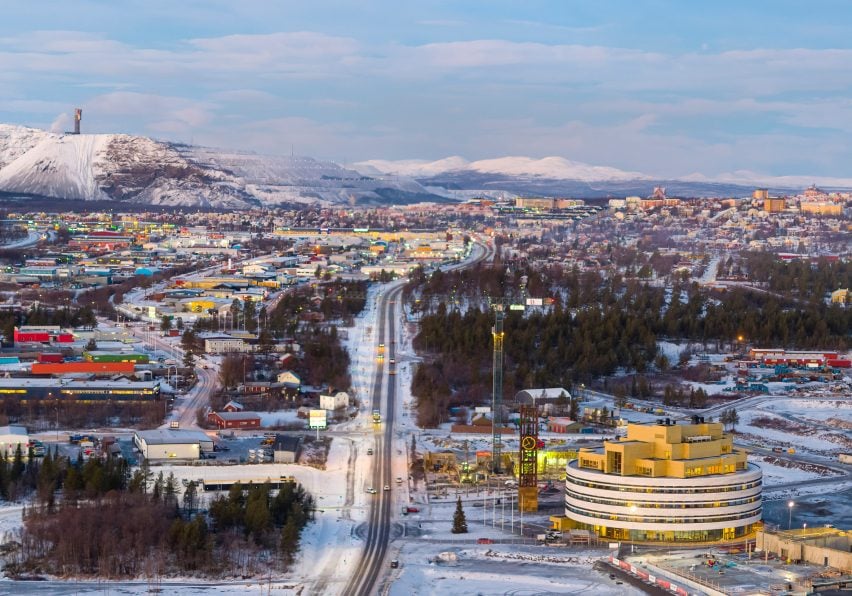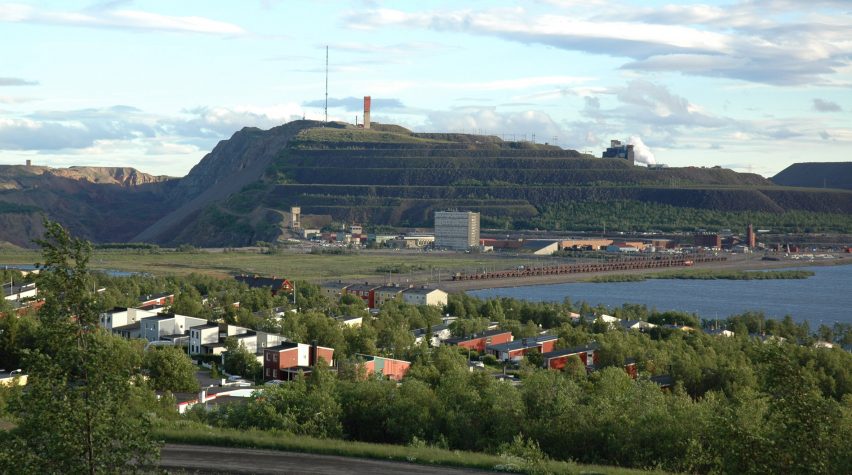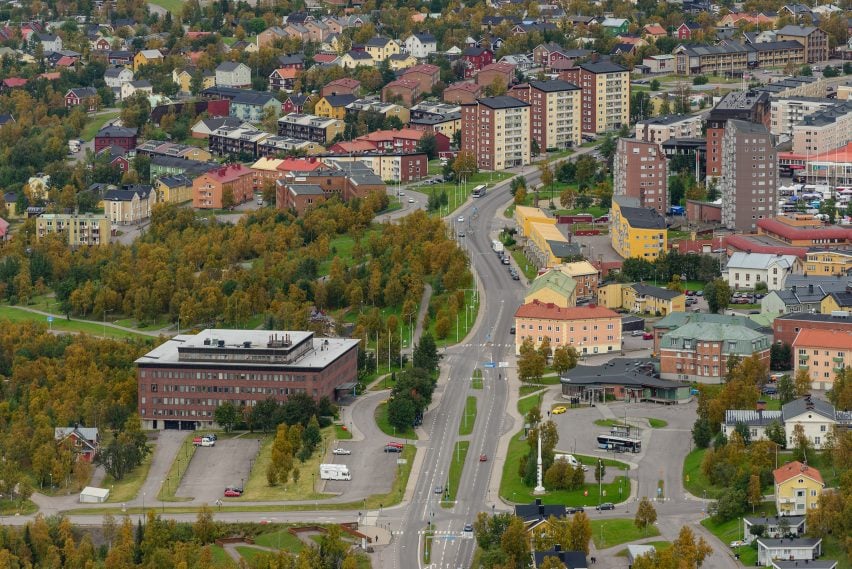
Biggest challenge of relocating Swedish town Kiruna is "moving the minds of citizens"
Human impact on the planet is forcing Sweden to relocate the town of Kiruna. The urban planners and architects behind the project say the biggest challenge isn't moving the buildings, it's bringing the community with them.
Sweden's northernmost town and its 18,000 inhabitants are moving two miles east, to prevent it slowly being swallowed by an underground mine.
The mining company, Luossavaara-Kiirunavaara (LKAB), and its owner, the Swedish government, are moving over 20 significant buildings from the old town of Kiruna to the new location, including its church, which was voted Sweden's most beautiful building. Each one is being completely dismantled and reconstructed.
The rest of the town is being built from scratch, with new buildings including a town hall designed by Scandinavian firm Henning Larsen, being created within a masterplan by White Arkitekter and Ghilardi+Hellsten.

While physically moving the entire town is a complex, expensive and – at the moment – unique challenge, relocating the community is proving the harder task.
"The challenge for the city is not only about moving an entire city, but also moving the minds of citizens and creating a new home and identity," said the Henning Larsen team. "The opening of the city hall marks the beginning of the moving process and the opportunity for creating a new social identity for the city."
"Handling history and identity is the tricky part"
The key challenge for the architects and planners of the new Kiruna has been understanding the elements that contribute to the town's history and liveability. While physically moving structures is difficult, it is logistically simpler than understanding what makes a town somewhere people feel at home.
"The physical things are easy, in a way. Building a town hall is easy," explained Göran Cars, urban planner for the Kiruna municipality.
"For a person who has to move you can ask, what is important to you? That person might say, 'I want to have a city hall with these qualities', and that's simple. But then how can we also handle history and identity? That's the tricky part," he told Dezeen.

Cars' team discovered that smaller and seemingly insignificant elements made a big difference to the sense of place. Predicting these was almost impossible. But by listening to residents, they were able to assess what things had the biggest impression on locals, and extended the scope of what needed to being moved.
"I was stupid coming up here, because I assumed that the way to maintain identity and preserve history was to move physical buildings," said Cars.
"We are moving the church. When I speak to people they say: 'Yes I know that, but what about a grave? How about the birches?' I didn't understand that. They are small trees! But they are 100 years old – as old as the church. I get the question time and time again: 'What about the birches?' So now we are moving the birches."
"Small artefacts can be very important in terms of something that is both identity and has history," he added.
Kiruna could be model for moving other cities
The state-owned mining company had been extracting iron ore from under Kiruna for almost 70 years. The outcome is that the ground above the mine is subsiding and will eventually swallow the land the town is built on.
The decision to move the town came in 2004, although the Swedish government was aware of the problem years earlier. As the first real-world example of a town of its size to be relocated, it could serve as a model for other cities under threat.

Like Kiruna, many of the world's coastal communities have also been facing impending destruction for years.
The United Nations' Intergovernmental Panel on Climate Change report states that the predicted 1.5 centigrade increase in global temperatures will lead to an average sea-level rise of between 26 and 77 centimetres by 2100. Higher levels of global warming will cause greater thermal expansion of the ocean and increased ice melting, with a two-degree increase potentially leading to the melting of the Greenland ice shelf and a rise of up to seven metres.
Around the world, this now inevitable sea level rise will lead to the relocation of millions of people by the end of the century, with some of the world's largest cities, including Miami, Mumbai and Guangzhou, under threat. The Maldives is already predicted to be uninhabitable by 2100.
In the future, moving large numbers of people may need to become commonplace. Kiruna could serve as a real-world example of how to tackle the very real prospect of relocating towns and cities under-threat around the world.
"Kiruna doesn't serve as model financial model"
Cars pointed out that, while Kiruna can demonstrate the physical and emotional process of relocation, its financial model is unique.
The town is fortunate in that its destruction is directly related to the highly profitable vein of iron ore it sits above. By Swedish law, the mine has to fund the relocation and has amble funds – and future revenue – to do so.
For the world's coastal inhabitants the financial situation is not so simple. There is no cash-rich organisation behind the problem, and no one willing to pay for its solution. Rising sea levels are the result of the global population's actions, but the impact will be borne by coastal communities, cities and countries.
"Kiruna doesn't serve as a model in terms of financing," said Cars. "Its a very specific situation."

Even with its funding covered, there are still strict restraints determining what can be moved in Kiruna. In the majority of cases moving is more expensive than simply building from scratch, meaning each building or item that is relocated comes with an additional financial burden to the mine.
"The thing is that if you have a balance in economy you should be extremely generous in what you move," explained Cars.
The only option for coastal communities would be funding from nation states. The likely risk is that countries with huge low-lying populations, like Bangladesh, will pay a huge price for impact of global pollution.
"I have had visits from a few countries that are facing this: Malaysia, some US states and the Netherlands of course," said Cars. "We discussed financial models and they all think that any option other than state or local or regional funding is not to likely to happen."
Urban planners can learn from Kiruna
Although it's not a financial blueprint, Cars still believes that architects taking on the challenge can learn a lot from Kiruna.
The key to its success, he claimed, will be the seriousness with which the urban planners have attempted to continue the town's legacy, while also providing high-quality new facilities appropriate for its current and future generations.
Communication also played a huge part, with residents constantly made aware of the ideas and plans, and invited to share their views on what the future town should be.
"What we have done correctly, is that we started with a dialogue," said Cars. "No drawings, no sketches, not a single bit of real detailed planning. Just listening. What are expectation, what is quality, what is attraction to people. Just listening and listening."
Main image is by Peter Rosén.